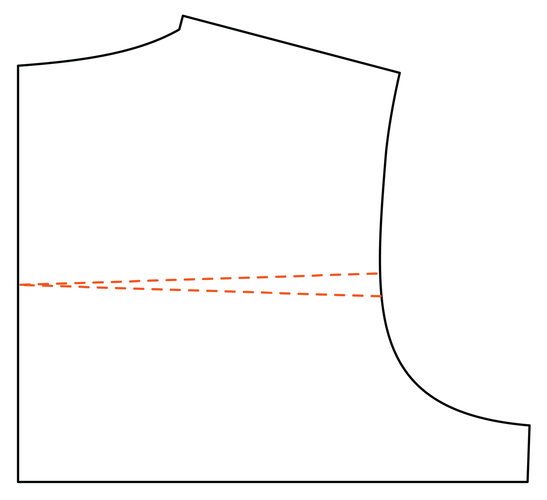
I’ve refined my workflow for fitting pants over the years, but I lack experience and confidence when it comes to tops. As the weather warms up, I want to revise my t-shirt pattern again. The long-sleeve shirts I made a few months ago were OK, but the fit never felt great. This four-part series will cover my fitting workflow with a new t-shirt pattern. I started with the Sage Tee from Elbe Textiles. I chose this pattern because it is more size-inclusive than the Union St. Tee and is drafted for a cis male body. I have always had better luck fitting into men’s clothes because the shoulder width is drafted wide enough for my body.
Style and Fit
There’s not a lot to say about the Sage Tee. It is a basic, relaxed-fit t-shirt with a crew neck. It comes with a short and long sleeve and a chest pocket. The shoulders hit slightly past the edge of the shoulder to give it that relaxed fit. The neckline is moderately high but not too high. In general, the shirt looks like a standard t-shirt.
Sizing
The pattern comes in 13 sizes and fits chests from 34 to 58 inches, waists from 28 to 52 inches, and hips from 32.5 to 56.5 inches.

My current body measurements are 41.5-inch high bust, 40-inch bust, and 36-inch waist. Because my high bust is actually bigger than my bust measurement, I used that as my starting point. Based on my high bust, I should start with size E, which also works for my waist measurement. I’m ignoring the hip measurement because I know I will have to widen the t-shirt for my hips regardless of size.
Preparing the Pattern
I’m loosely following J Stern’s bodice workflow, but I am ultimately trying to find a process that works for me. I will say it repeatedly in this fit series, this is by no means a complete tutorial on how to fit a top. Neither is this a tutorial on how to get a “perfect” fit. This series is purely about the workflow I used to make this pattern fit my body. I really like the idea of creating a personalized step-by-step method for fitting. It improves the efficiency of the whole muslin fitting process. It breaks the process down into bite-size, manageable pieces. It reduces the stress and frustration of fitting. And ultimately, it sets you up for better success with your garment. All great reasons to develop your own workflow for making sample garments!

The first place I started was at the shoulder. I added a few inches to the shoulder seam. Next, I drew a line 1 inch below the armhole and removed everything below that. Because this isn’t a fitted knit top, I just used woven muslin fabric for my initial fitting. Later in the process, I used knit fabric to make sure my adjustments worked.
Fitting The Shoulders
This first part of the fitting focuses only on the shoulder portion of the shirt. If the shirt doesn’t drape off the shoulder correctly, the rest of your fit adjustments won’t matter. This is similar to setting up your waistband placement on your pants first before diving into other fit issues.
Here are the key steps I focused on when fitting my Sage Tee. I start by adjusting the muslin until the center front and center back at the bottom (i.e., chest level) are on the same horizontal plane. The sides will droop down and do their own thing. I’m only concerned about the alignment of the dead center front and center back points along the horizontal plane.
- Does the shoulder seam sit on top of my shoulders? Or is it falling forward or backward? Does my outer shoulder line up with the shoulder seam?
- Does the shoulder slope match my shoulder slope?
- Is the shoulder seam long enough?
- Is the neckline placed where I want it? Does the neckline match the overall style intended by the pattern designer?
- Is there gaping or tightness at the center front/back of the neckline?
Shoulder Seam Placement
Shoulder Seam Falling Backward

With the bottom center front and center back on the same horizontal plane, I study the placement of my shoulder seams on my body. If the shoulder seam wants to fall backward, that could mean that the front shoulder length is too long and needs to be shortened:

Or the back shoulder is too short and needs to be lengthened:

You may even need to make a combination of shortening the front shoulder and lengthening the back shoulder at the same time in order to keep the shirt balanced. An unbalanced shirt will fall off your shoulders and not stay put.
With a baggy shirt like this, it is hard to know which adjustment is the best. That’s why I make muslins and added an extra seam allowance at the shoulder seam to play with length. It is important to wear the muslin for a while after each change to see if the shoulder seam moves.
The most significant indication that I need to make this change is excess fabric pooling around the top of my armpit and/or the shoulder seam falling backward.
Outer Shoulder is Forward

If the shoulder lines up with the seam at the neck, but the outer shoulder is forward of the seam, then you need to move the outer shoulder point forward. I have to make this adjustment for every pattern I’ve ever used.

Shoulder Seam Slope

I loved having the extra seam allowance so I could experiment with a steeper and flatter shoulder slope on my t-shirt pattern. If you have draglines (i.e., tightness or pooling) at a 45º angle from the outer shoulder, tinker with the angle of the shoulder seam.
Adjusting the shoulder seam can also remove puckering or tightness around the neckline if it is happening at a 45º angle to the center front and center back.
To change the shoulder angle, you should make the same adjustment to the front and back outer shoulder points.
To flatten the shoulder seam, raise the outer shoulder point on both the front and back pieces:

To steepen the shoulder seam, lower the outer shoulder point on both the front and back pieces:

Shoulder Seam Length
Shoulder seam length wasn’t an issue with this pattern because I chose a pattern I knew would have wider shoulders than a t-shirt pattern drafted for a cis female body. Depending on your shirt’s style and body, you may need to widen or narrow the shoulder seam. If the shirt is drafted to be slightly off the shoulder, then make sure you adjust the pattern so it does the same thing on your body.
Neckline
After the shoulder adjustments, you may find the neckline is lower or higher than how the original pattern intended. Now is the time to adjust the neckline placement.
Narrow Center Front/Back
Even though you’ve selected the correct size, you may find (like me) that your front body is a size or two smaller than the size you selected, and your back body is a size or two larger than the size you selected. I’m still trying to figure out the best way to pick a size for tops. I find it easiest to go big and fit the largest part of my body. Then I only have to pinch out excess instead of trying to determine where to add fabric.

If you have excess fabric along the center front along with the armhole extending beyond your body, this is a good indication that you could pinch out some of the excess all along the center front.

Even if you pick the right size, it may still be a bit too big for the back. Again, if you have excess fabric along the center back, in conjunction with the armhole extending past your body, you may want to try pinching out the excess along the center back.


Widen Center Front/Back

I try to avoid this scenario with my size selection. However, you will need to add room along CF if you have tightness and pulling across the front of the shirt and the armhole does not extend all the way out to the side of your body. The shirt is trying to pull the circumference from the back body, which causes a lot of draglines in the back as well.

A good indication that you may need to go up a size or add length to the center back is if it is tight across your shoulder blades and the armhole doesn’t reach the side of your body. Again, the shirt will try to pull the circumference from the front pattern piece and cause draglines.

I work based on trial and error, so it’s OK if you can’t decipher between adding and removing CF/CB. You are only working with this small bit of the pattern, and it’s simpler to test different scenarios than if you were working with the whole pattern. Sometimes, I’ll make a change that’s wrong, just to see how it feels. There’s a lot to be learned from mistakes. Don’t be afraid to experiment.

Final Fit

Here’s the final look I tried to achieve with the Sage Tee. The shoulder seam lined up with the top of the shoulder. The bottom of the center front and back were on the same horizontal plane. I removed any puckering or tightness along the center front and back.
Like the avatar, I still had some excess fabric around my shoulder blades, specifically the vertical darts forming around either side of them. The changes above (e.g., adjust shoulder slope, lengthen back shoulder, adjust CF/CB amount) fixed most of the issues. However, the remaining excess fabric is because I needed to remove a wedge from the back piece. This change only worked if I had a center-back seam, because when you remove the wedge the CB seam is no longer vertical.

If you have a clever way of removing this wedge while still being able to cut the fabric on the fold, let me know in the comments.
In Part 2, I will cover adjustments to the armhole. Stay tuned for more!











